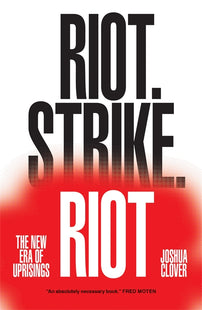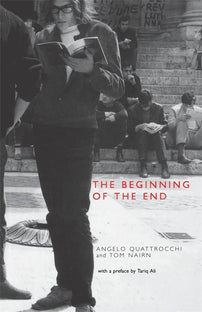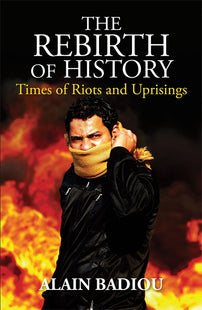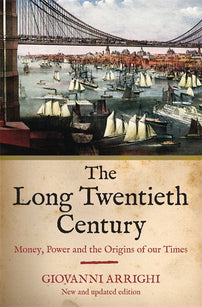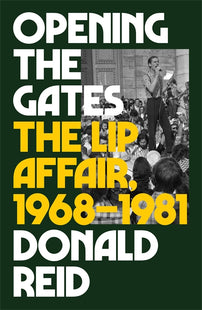Workers Leaving the Factory: From May 68 to October 05
May 1968 stands at the precipice into which the historical labor movement will descend.
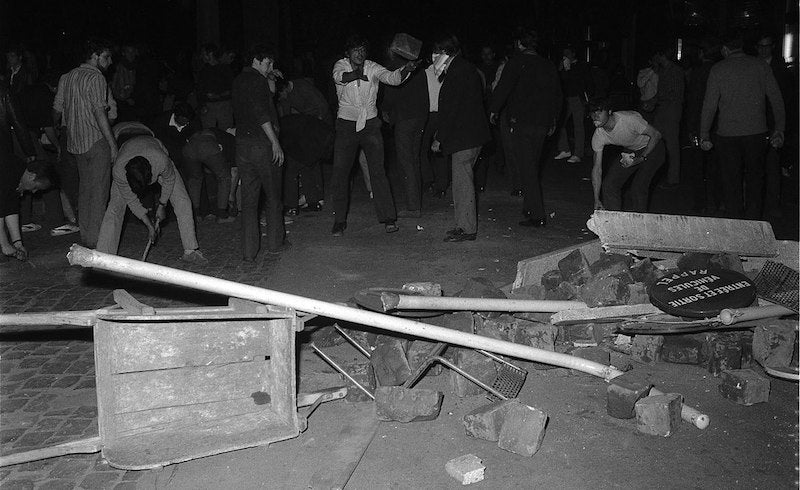
Adapted from the preface to the French edition of Riot.Strike.Riot.
On the morning of June 10, 1968, four students from L’Institut des hautes études cinématographiques (IDHEC) made their way north across Paris to the Department of Seine-Saint-Denis. The neuf-trois, per its postal code, includes 40 communes. One of them, Clichy-sous-Bois, would be the origin of riots that spread across the nation and beyond 37 years later, leaping from banlieue to banlieue by the light of burning cars, arriving in the immiserated quarters outside Lille and Toulouse more easily than the gleaming center of Paris. It is no doubt because of this discontinuous transmission that the Invisible Committee would suggest, two years later in The Coming Insurrection, that “revolutionary movements do not spread by contamination but by resonance.” A poet might say, riots spread not by metonymy but by metaphor. It is in any regard an ambiguous and suggestive claim, leaving open the question of what it is, exactly, that resonates from Saint-Denis such that a thousand banlieues vibrate back. The neuf-trois is also the home to one of Europe’s liveliest hip-hop traditions, a fact occasionally drafted to explain the 2005 riots. More commonly, blame attached to immigrants and other racaille, the word carefully selected by then-interior minister Nicolas Sarkozy. Less than a month after the riots began, the government announced a new policy which would become the French Immigration and Integration Law, designed to diminish and reconfigure the flow of populations toward high-skilled workers who would integrate more graciously into the formal economy and thus into society, if we are to uphold that distinction. More aspirant members of the classes moyennes; fewer racaille. That was the plan.
But we are getting ahead of ourselves. Let us return to 1968, on the chance that there is still a lesson to be found in that rusting factory of wonders. On May 16, IDHEC students joined the general strike. Four days later they collectively decided to allow the making of films documenting the “movements of students and workers,” as well as the Vietnam War negotiations then happening in Paris. The June 10 film would be their third and final. In the interim, the Grenelle Accords had been announced but remained unratified. Strikes continued unevenly against the will of the CGT, the students still held the Sorbonne. On May 29, two days after the agreements, de Gaulle decamped for the military airfield in Baden-Baden to meet with its overseer, General Jacques Massu, esteemed paratrooper, torturer, and former prefect of Algiers.
This meeting is sketched in with rumor and myth. Some say that De Gaulle simply wanted to pass some time out of view. Massu claimed that the President of the Fifth Republic bruited resignation, but that the general stiffened his spine. In some tellings, de Gaulle granted amnesty to the patriots who had once from their garrisons in North Africa dreamed of a coup against the French government for its willingness to relinquish Algeria. In return, he was assured the support of the military should France now rise into open civil war.
It is an opaque moment. Certain coordinates are clear, however. Over the course of May the republic enters into real and total crisis. There are two armies arrayed against it. One is the workers. Their weapons are the work stoppage and the factory seizure: the decisive tactics among “production struggles,” the tactics available to those on whom production depends, for whom the formal wage is the orienting fact of their ability to reproduce themselves. At the peak, perhaps nine million workers are on strike, nearly half the national work force. The other army is identified with the students, an identification both common and incomplete. They speak often in the language of “strike.” This makes sense if one understands the word to indicate a refusal to participate in the smooth reproduction of state and capital. It also misses a series of distinctions that will only grow more critical in the following years. This second army’s weapons are the occupation, the barricade, most spectacularly and most famously the riot with its paving stones arcing through clouds of tear gas: the arcana of tactics elsewhere defined as “circulation struggles.” These are the weapons of those whose reproduction is not oriented by the formal wage, who lack much access to the gears of production, but who are still dependent on the market — whose lives are lived in the noisy sphere of circulation.
So then: strike and riot. They do not necessarily get along. Indeed the leaders on the side of strike in 1968 mandate that workers must not mingle with the students, the side of riot. When the occupants of the Sorbonne march to the Renault factory at Billancourt, surely the moment of greatest risk, the Parti communiste français warns instantly “against all adventurist calls for action” and the Confédération générale du travail blocks the entrances against commingling. In the words of the Council for the Maintenance of Occupations, “the workers have against them a bureaucracy infinitely more powerful and entrenched than that of the student or leftist amateurs.” This antagonism among the higher organizational tranches is exemplary of the historical trajectory through which these two distinct forms of struggle within what Charles Tilly calls the “repertoire of collective action” are set in opposition, and that opposition becomes a kind of common sense. An ideology. This frozen ideological opposition has, in its broadest lineaments, extended beyond a simple preference for one form against another — a curious development itself, as it is clear that the ways in which people fight against immiseration, against dispossession, fight to assure their survival and that of their communities, arise from the most basic material affordances of their lives, not from some ideal preference. However, the opposition of strike and riot has in main evaded a debate over tactics via the insistence, in advance of any combat, that one form counts as politics and one does not (other than in some incidental sense wherein everything counts as politics). Certainly the last two centuries have labored to recognize riot as a form of class struggle or, more pointedly, have labored to occlude this fact. But it is. It is a form that predates the existence of the strike but not the existence of social class: a form in truth out of which strike emerges, and into which strike eventually recedes. They are part of a single dialectical motion, neither vanishing once it comes into being, each rising and falling against the other.
This is one of the core arguments of Riot.Strike.Riot: that riot is a particular form of class struggle which arises from a world where market dependency generalizes in advance of wage labor; passes to those shipwrecked in the sphere of circulation while parts of the world make their epochal shift toward industrial production; remains with those who are never subsumed by that production; is rediscovered by those who are recirculated, let us say, when production declines. This does not mean that struggles over market survival provide the manifest content of any given riot (though sometimes this version of “price-setting” is a the heart of things, particularly in the era of the bread riot). It means that the leap into riot is conditioned by the position from which its participants begin. Proletarians, but not necessarily workers. At least not according to the cruel and sentimental image of a national working class that developed across the industrial west. That this long, uneven, and violent parsing of populations been conducted consistently by reference to race, ethnicity, and gender — and that it has helped to impose those categories in turn — has obscured the political-economic logic of the riot even further. The riot is the class struggle of the excluded, which over and over in our era turns out to mean non-white proletarians.
The other core argument is the complement to this claim about class struggle. It is already implicit above, and concerns the history of capitalism writ large, and the modes of class being and belonging that it has produced. The history of riot is the history of capital accumulation inverted, and punctuated by crisis. In looking at the historical fall and rise of riot in the early-industrializing West, we can deduce a schematic, suggestive history of capitalism as a whole. This model, like all models, is inadequate to the endless particulars of life. And yet it is a model with certain descriptive capacities nonetheless — and at least as significantly, one with predictive powers. Capital is a social relation, Marx insists. This violent abstraction comprises a vast and variegated array of concrete relations, developing unevenly, escaping every model, and scarcely limited to the paradigmatic pairing of boss and worker. Within this miasma, we can nonetheless make out the following motion: capital begins by drawing more and more people into the formal wage, what Marx calls “formal subsumption.” At the same time, it is compelled ceaselessly to improve its productive powers, what he calls “real subsumption,” replacing human labor with machines and inevitably expelling people from that same formal wage. The labor market expands even as it casts off surplus. Can both of these be true at once?

Yes, for a while. If reducing the production cost of a commodity allows a firm to enlarge its market, it will hire even more employees to accompany even more machines; even as the ratio of machines/humans rises, total employment can rise too. But eventually the market grows saturated and the firm seeks its profits not through expansion but through simple cost reduction. Hiring levels off, and then begins to decline. This is the moment we call “deindustrialization.” It marks not the end of industrial production but the threshold after which industry can no longer serve as engine for the integration of labor and capital. The service sector, the tertiary sector, grows inexorably — but not enough. The great shift wherein industry once absorbed all the labor cast off by the extraordinary transformations of agricultural production cannot be repeated. Those who cannot be absorbed in the service sector return to informal economies, finding ways to capture a share of someone else’s wage at peril of starvation. Here the gap between proletariat and working class, which had for near on two centuries drawn closer such that we began to treat the categories as identical, begins to open again. And the riot, which had surrendered pride of place within the repertoire of collective action but surely never gone away, reasserts itself.

Riot.Strike.Riot arrives eventually in the city of Detroit around 1967, meditating on a signal moment when circulation and production struggles cross wires, or cross paths. For a moment they come together. It will not last. One form rises in the old auto-manufacturing capital while the other wanes, exemplifying the larger trajectory that concerns the study. Though their fates are different, this moment of confluence is revolutionary. It is this confluence, and its unwinding over the years that follow, that allow us to narrate the forms of contemporary political combat and the course of capital.
The same can be said about Paris 1968, where riot and strike come briefly together, a flash of illumination that has dimmed only because we have stared so long. The situation in Paris is of course different. There is no Black Panther Party of Detroit, no Dodge Revolutionary Union Movement, no Inner City Voice newspaper. One might search for cognates among the comités d’action, the more radical quarters of the Confédération française démocratique du travail, in the leaflet pages of De la misère en milieu étudiant. It would be a mistake to exaggerate the similarities, not least for the ways that the Detroit Rebellion, paradigmatic of the new era of riot, articulates itself around race — and in the United States specifically around the bloody inheritance of chattel slavery. It would equally be a mistake to ignore the entanglement of racial domination and of immiseration organized according to labor force access, an entanglement that operates at a global level, from Detroit to Clichy-sous-Bois, from Tottenham to Gothenburg — a process that sets forth who can strike and who cannot. Who in the moment of crisis will find themselves athwart the assembly line, spanner in hand, and who will find themselves pulling up an iron grate from a sidewalk planter to improvise a shield. These are the two armies. In the face of their double appearance in May, De Gaulle draws on everything at his disposal. And finally, he calls upon the guy who in forty years of military service has demonstrated among his many talents a singular gift for violently imposing colonial order.
These are large events, dramatic events. The IDHEC students’ film itself is fit to a smaller scale. It is ten minutes in duration, and has only one or two cuts. It has the fairy tale title of “Return to Work at The Wonder Factory,” La reprise du travail aux usines Wonder (the subtitles are dubious, but they get the gist). It reaches back to the origins of cinema, 1895’s La sortie des usines Lumière, and forward to 2011’s Workers Leaving the Googleplex. That is a long century right there. It is fair to say that the matter of workers entering and leaving factories, the problem of the proletariat, is one of cinema’s fundamental thematics. Cinema cannot stop capturing moments in the global epic of labor, the ceaseless cycle of katabasis and anabasis that possesses the dispossessed. They are always leaving or returning according to the great flux and reflux of the work day, the work week, the labor market itself which proletarians are always entering or exiting, absorbed or expelled according to the needs of production and the demands of profit. In the original Lumière films, many of the exiting workers are women; this latter version also focuses on female labor. The narration begins, “Dans la matinée du dix juin, 1968, après trois semaines du grève et d'occupation d’usine, des ouvriers de Wonder, à Saint-Ouen, réunis par le patron, ont voté la reprise du travail, par 560 voix contre 260.” [On the morning of June 10th, 1968, after three weeks of strike and factory occupation, the workers at Wonder, in St Ouen, gathered by the boss, voted to return to work]. Then it introduces the main action: “Le jour meme, à 13:30….”
The main action is this: a woman does not wish to return to work. She does not want to accede to the vote. The functionaries from the CGT explain, placate, all with bureaucratic sang-froid; occasionally a Maoist établi looks on. Her comrades voted, it is explained to her. They speak to her like a child. It was fair. There will be a raise. There will be no reprisals against workers, against her; the union will assure this. She is unmoved. Or, rather, she is moved more passionately in the other direction. Passion is one word for it. She is agitated, vehement. The motion will be familiar to many, particularly its gendered aspect. The men are figures of pure paternalistic reason. They provide the rebuttals that they have been trained to offer at exactly this moment of danger. They clasp her shoulder in consolation. She looks down, crosses her arms. backs away, does whatever it takes to make just enough space to gather what she knows. It is like she is shaking off a spell each time. They haven’t addressed the real matter at all. She again starts to speak. It is excruciating to watch and mesmerizing. The woman keeps saying NO, shouting NO. She does not wish to exchange absolute negation for a few more vacation days. Any fate but that of being absorbed back into the factory: “Non, je rentrerai pas, non je rentrerai pas là-dedans. Ça je mettrai plus les pieds dans cette taule” [No, I won’t go back, I won’t go back in there. I won’t set foot back in that cell]. But she will, we know she will. This knowledge is painful. We know that stories that end with the return to work are not triumphs but tragedies.
Kristen Ross suggests that the woman is also a figure for the historical moment itself: “the ghostly presence of the woman as pure refusal, momentarily at the center of our gaze, suggests a kind of historical condemnation whereby ’68 becomes itself spectral, partaking of the peculiar spectrality and ungraspability of the recent past in the minds of those whose past it is.” Briefly but absolutely present, the woman vanishes. Decades later, for a metadocumentary called Reprise, a team will track down the original filmmakers and all the figures who appear in the film, except for our epic hero; she remains known only as “The Woman Who Says No.” We don’t know too much about her. She likely works on the filthiest part of the line. If she has any friends among her co-workers they do not appear. She does her hair in the style of Anna Karina, as people did — Karina as she had appeared most recently in Lo Straniero. This is Luciano Visconti’s version of L'etranger, that tale driven by the murder of an Arab in French Algiers, finally put to film in 1967. It had showed in Paris recently. The Battle of Algiers was its hidden twin, a present absence in Paris, made in 1966 and immediately suppressed for five years in France. Its principal French character, Lieutenant-Colonel Mathieu, is based on the paratrooper Massu. Why does this keep returning, this question of Algeria, of the colony? And what has it to do with a rift torn open in the politics of work in a northern suburb of Paris, six years after the Evian Accords made Algerian independence official?
Everything, obviously. The Woman Who Says No lives in the same city where Guy Debord scrawled NE TRAVAILLEZ JAMAIS on a wall in 1953. Over the years, however, the refusal of work increasingly appears not as some ultraleft irrealism but simply as a registration of the circumstance of labor. The discontinuous, gargantuan, two-century long expansion of capital, its capacity to absorb every labor input driven into its embrace by dispossession and the promise of a washing machine, or maybe even a Renault, is running out of steam. The struggle for full employment, for worker control over production, for the full set of measures and programs associated with the socialist project begun in the 1870s, is ebbing as well — not out of some failure of political will so much as real transformations of the class relation accompanying declining profits, deindustrialization, automation, financialization, the counterrevolution in logistics. Henceforth organized labor will struggle not to unmake capital from within but to preserve it as a going concern — not in every instance, but with such increasing consistency that it takes on the aspect of a revised class relation. On this June afternoon, “absorptive capitalism” has already tilted toward its end, an end punctuated by the dusk of les trentes glorieuses, by the long global crisis that begins in earnest in 1973, the winding down of the American engine.
But for some it never truly began. This is the thing that we are forever asked to forget. In the former and persisting colonies, a different political economy obtains. Those whose lives are uprooted by colonial settlement and seizure are far less likely to make their ways into the urban economy than were French peasants in 1900. Fanon offers the Dantean vision of those who, displaced from family farms, are condemned to circle the towns looking for a way in. They will not find it. Populations are disciplined not by the wage but by the whip, by the direct application of ongoing brutality that defines the colonial scene. It is in this situation that the lumpenproletariat, counterrevolutionary to the core in Marx’s figuring, become instead Fanon’s revolutionary “urban spearhead” of insurrection.
These are the figures that haunt Paris in 1968, haunt Saint-Ouen. Neither the workers of Wonder (and ten thousand other factories) nor the students of the Sorbonne (and ten thousand others schools) are the lumpen that Fanon imagines, but both point in that direction. The students, and we can be certain that they are joined in the nightly melees by legion non-students, may find themselves sequestered in the sphere of circulation only temporarily, though it is true that their degrees will in time cease to function as free passes into the salariat. No doubt the spectres of Papon’s massacre of Front de libération nationale marchers in 1961, and the Charonne murders of 1962, hover in the air. No doubt the nights of 1968 are a presentiment of the riots to come. Nonetheless, the students are more an allegory for the lumpen than representatives. Very well. Allegories are warnings.
Meanwhile we are at the precipice into which the historical labor movement will descend. We are equally at the base of an ascent, less steep but no less significant, of exclusion from the formal wage in the postindustrial core. The gap between working class and proletariat, from here on out, widens. The fact of these two sets being non-identical is the fact of the lumpen, those who confront a chronic condition of being surplus population — surplus, that is to say, to the needs of capital. Those for whom the labor market, the return to the factory or the office tower or the mill, no longer presents itself as a solution to their misery. The lumpen are those to whom the factory says NO. Their own NO returns against everything.
The film is a prescient view of this development. And development is the right word. It designates among other things, even in the well-worn invocation of “combined and uneven development,” a rising productivity and declining labor force; the development of productive forces is the development of surplus populations. Where the worker is, the lumpen will be. This development scarcely begins in 1968. It is already in progress, settling on the landscape unevenly. We might say the woman’s NO is the arrival of lumpen politics within the precinct of the white worker, the sentimentalized national working class mentioned above. She knows, let us imagine, that the NO is coming, and arrives there first. And yet she is not, in that moment and in that word, a figure of “pure refusal,” as Ross has it. Or: she is, she absolutely is. But she stands at the chiasmus of a vast and complex historical double process; it passes through her, she bears it for a moment. We have mentioned already “the problem of the proletariat”; that is Cesaire’s language, though he seems to mean the traditional working class. The full passage from his Discours sur le colonialisme gets at the full picture.
Le fait est que la civilisation dite «européenne», la civilisation «occidentale», telle que l'ont façonnée deux siècles de régime bourgeois, est incapable de résoudre les deux problèmes majeurs auxquels son existence a donné naissance : le problème du prolétariat et le problème colonial….
[The fact is that so-called “European” civilization, “Western” civilization,” as it has been fashioned by two centuries of bourgeois rule, is incapable of resolving the two great problems to which its existence has given birth: the problem of the proletariat and the colonial problem…]
Two different problems, though they share a history. Two different modes of discipline. Two different demographics. The colonial subject is marked as not white, marked ideologically as not properly British, Scandinavian, American, French. It is a system of social coding that saturates the short film’s discourse. The tar and chemicals coat the workers, we hear, it colors them, there is no hot water to wash it off. “Hein, rentrez-y, vous allez voir quel bordel que c'est. On est dégueulasses jusqu'à là. On est toutes noires” [Hey, you go back, go see what a shithole it is. We’re covered in filth up to here. We’re all black].
On est toutes noires. We are all black, we are all blacks. We are not, of course, any more than the literally poisoned workplace is the same as a jail cell. There is little to gain from annihilating the differences within the planetary population of the dominated, just as there is little to gain from ontologizing these differences. It is nonetheless important to stay inside this moment for as long as we can, to see the full array of issues, of problems, of possibilities cached here. Seen from here, the story of Paris ’68 is the story of Cesaire’s two problems, two problems with different trajectories that in this passage intersect, cross, and begin to diverge, leading away from May and June and into a future where the riot increasingly features while the strike begins to fade away, where the working class wage can no longer hold the social structure in place, where it must be ever more policed, ever more imposed by direct force. Where even in the cosmopole, the problem of the proletariat increasingly resembles the colonial problem. No wonder De Gaulle’s peregrinations do not culminate with Chirac and Seguy on the rue de Grenelle but with Jacques Massu in Baden-Baden. Not with the specialists for managing the working class, but the specialist of the racaille.
“Racaille” is often translated into English as “scum.” This is also how “lumpenproletariat” is described in the Communist Manifesto: “the social scum, that passively rotting mass thrown off by the lowest layers of the old society.” The word on rare occasion serves as translation for lumpenproletariat into French, most splenetically in Engels’ 1870 Preface to his Der deutsche Bauernkrieg. Nineteenth-century European Marxism had little interest in their political possibilities; twentieth-century Marxism from the colonies much more so. It is not that one faction is correct, the other mistaken. This is not the form that historical analysis takes. Rather we can trace across time a certain set of transformations, both in the class composition and global organization of a racialized capitalist order, which require of us a different understanding of the political valences of lumpen struggle. It is possible for Marx and Engels to be right in their time and Fanon in his — and for these transformations to continue.
If there is a line that connects the Casbah to Saint-Ouen, it continues on to Clichy-sous-Bois, to the deaths of Zyed Benna and Bouna Traoré in flight from the banlieue cops, those little Massus. We can now perhaps begin to answer the question of what resonance joins Seine-Saint-Denis to ten thousand banlieues in 2005. Surely they vibrate together, breathe together — this is all that inspiration means — because they share a structure of exclusion. The French Immigration and Integration Law could no more legislate a return to economic growth than could any other set of words on a page. The national fantasy of an immigrant middle class, assimilated, absorbed, takes its distance from the reality of economic and political refugees pushed out of the city and into the informal economies of circulation according to the cruel logic of race and capital. Thus the contemporary and insistent form of the “suburban riot,” the form of struggle immediately available to the classes warehoused in the exclusion zones that ring the great cities, growing every year. It is in this sense that 2005 is an illumination of 1968. This is true at the most literal level. One must insist on a fiction more true than the truest fact. Let us say that the first illumination of Clichy-sous-Bois was a burning Renault 5 Supercinq, a very particular one, thirteen years old, the very last car to roll off the line on the very last day of work at the Île Seguin plant. The auto factory, the largest in Europe in 1968 and the largest to go on strike, covered the entire island, a sort of industrial fairytale. The golden age, before the fall. It closed in 1992. Things happen more or less on time. For more than a decade it sat there, a dead factory-island, silent and gloomy, until it was finally demolished in 2005, the year of les voitures brulées. Everything burns.
[book-strip index="1" style="display"]